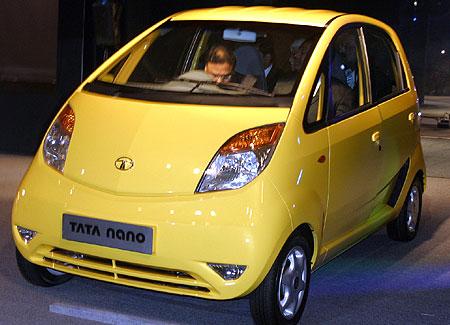 | « Back to article | Print this article |
 Nano. A prefix meaning one billionth. What better way to revolutionise the way a billion people travel than with a prefix indicating one billionth? A 623 cc car may not necessarily be your idea of ideal transport, but this could just be the vehicle to take your portfolio places.
Nano. A prefix meaning one billionth. What better way to revolutionise the way a billion people travel than with a prefix indicating one billionth? A 623 cc car may not necessarily be your idea of ideal transport, but this could just be the vehicle to take your portfolio places.
Pre-Nano. Even before the Nano blitzkrieg, Tata Motors has been a compelling story. With revenues of Rs 32, 426 crore (Rs 324.26 billion), it is the country's largest automobile company. Even though the Nano does not have any immediate plans of going global, Tata Motors' global foot print is also significant. Tata Daewoo Commercial Vehicles Company caters to the South Korean market and also constitutes two-thirds of the commercial vehicle exports of that country.
The company also holds 21 per cent stake in a Spanish bus and coach manufacturer, Hispano Carrocera, as well as a joint venture with Brazilian Marcopolo, a leading company operating in the body-building segment for buses and coaches.
In 2006, Tata Motors and Fiat Auto formed an industrial joint venture at Ranjangaon, near Pune, to produce both Fiat and Tata cars and Fiat powertrains for the Indian and overseas markets; Tata Motors already distributes and markets Fiat branded cars in India.
Financials. The net sales of Tata Motors have grown by 27 per cent, compounded annual growth rate (CAGR), to Rs 26,660 crore (Rs 266.6 billion) in 2006-07 from 2003-04. In comparison, the net profit has grown by 33 per cent to Rs 1,913 for the same period.
Currently, operating and net margins stand at 11 per cent and 6 per cent respectively. The return on net worth has improved from 29 per cent to 31 per cent in 2006-07 from 2005-06. EPS has consistently improved in the last four years. It has gone up to Rs 46.34 in March 2007 from Rs 25.79 in March 2004. Tata Motor is available now at a PE multiple of 12.10.
Why invest? The company is expecting to sell 15,000-20,000 units per month of Nano by the end of FY 2009, once production stabilises. At a very conservative margin of 5 per cent, this adds close to Rs 100 crore (Rs 1 billion) to the company's books.
Global auto analysts predict that in the next five years Tata Motors will sell over 12 lakh units of light vehicles per year, of which Nano will constitute more than half. The company is also in the process of finalising the distribution strategy for the Nano. Ratan Tata is looking at some variations of the traditional model of distribution that would help the company maintain its margins too.
If prices of steel and other inputs increase, Tata Motors would have a problem holding on to the Rs 100,000 tag -- which really is the essence of the Nano. Its Nano may also force other players like Maruti to drop prices on its lower end models. In the next few years, the Nano could also be exported, and there would be a big market, especially in other Asian countries and Africa.
In the badgering that the market took mid-January, share prices have tumbled across the board, making this a good time to buy a long-term bellwether like Tata Motors. On 3 January this year, the scrip was trading at Rs 816. This is now available for Rs 700-odd.
If Nano is the silver lining for four member families who so far had to totter dangerously on a motorbike, this 30 per cent plunge in share price of Tata Motors is the good news emerging from the carnage on the Dalal Street. Its demand is expected to be so high that certain political parties have written to Ratan Tata to ensure that the Nano is not hoarded. As an investor, this can't be bad news.